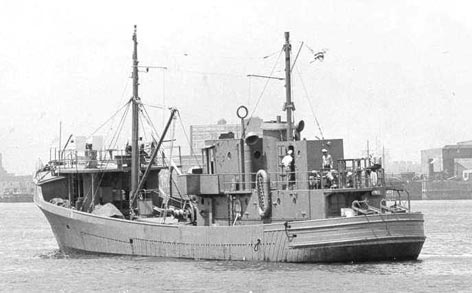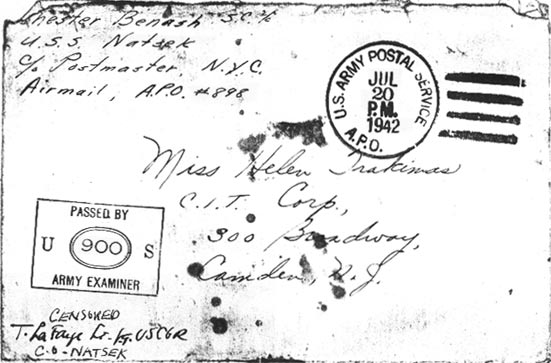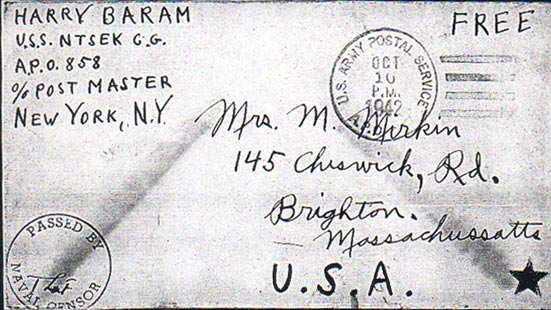
Last seen 17 December 1942 off Belle Isle Newfoundland in a blinding snowstorm.
Lost with all hands aboard. Believed to have capsized due to icing.
USCG Cutter Natsek WYP 170

Last seen 17 December 1942 off Belle Isle Newfoundland in a blinding snowstorm.
Lost with all hands aboard. Believed to have capsized due to icing.
|
Ship # |
Name |
CG # |
Year |
Type |
|
WYP 170 |
Natsek |
- |
1942 |
Trawler - ex. "Belmont" |


|
Ship |
Postmark |
Date |
Sender |
Note |
|
Natsek (WYP 170) |
APO (858) |
20.7.42 |
Chester Benash SC 2/c - APO 898 |
Mayo |
|
Natsek (WYP 170) |
APO (858) |
10.10.42 |
Harry Baram |
AB |
|
Builder: Snow Shipyards, Inc., Rockland, Maine |
|
CUTTER HISTORY: The wooden fishing trawler Belmont was acquired for service for a fee of $2,122 to serve under charter by the Navy "for Coast Guard use as a vessel of the Greenland Patrol." After conversion, including the addition of two small depth charge tracks and minimal anti-aircraft armament, she was commissioned as a vessel of the Coast Guard on 19 June 1942 and renamed Natsek, after Greenland's Natsek Fjord. Lieutenant Junior Grade Thomas S. LaFarge, USCGR, was given command and assigned a crew of 23, including one Navy enlisted man. She was immediately assigned to CINCLANT and the Greenland Patrol and was homeported in Boston. She set sail for Greenland waters in company with USS Bluebird, USS Atak, CG, and USS Aivik, CG, as part of CTG 24.8 on 29 June. She arrived at Bluie West #1 (Narsarssuak) on 20 July after making stops at Casco Bay and Argentia. She sailed in Greenland waters, supplying the Bluie stations through the month of August. Beginning on 28 September, she set sail from Narsarssuak to transport supplies, equipment, and personnel to Skoldungen to establish and build a weather station. She arrived there on 12 October. She continued on to help establish another weather station, this time at Torgilsbu and later that month another one at Skjoldungen. On 9 November she was ordered to assist in looking for a downed plane along the southeast coast of Greenland. On 15 November she then received orders to escort the USS Belle Isle to Torgilsbu from Skjoldungen. She accomplished the escort without incident and arrived at Torgilsbu on 16 November. She departed Torgilsbu on 23 November and arrived at Narsarssuak on 30 November. On 14 December 1942 she departed Narsarssuak, with the USS Bluebird and USS Nanok, CG, to return to Boston. Bluebird was under the command of LCDR James F. Baldwin, USNR, and he was the senior officer of the three ships. Nanok was under the command of LT Magnus G. Magnusson, USCGR LCDR Baldwin had conferred on 13 December with LTJG LaForge and LT Magnusson to arrange that the ships would proceed to Boston in column, with Bluebird leading. BLUEBIRD PARTS COMPANY The Bluebird and Natsek got underway about 0800, and the Nanok delayed about half an hour to receive mail and passengers. The Bluebird, while proceeding down Skov Fjord, closed the North Star to receive mail and a passenger. The Nanok also took on board an Army meteorologist as a passenger. The Nanok then joined the Natsek and, receiving no signal from the Bluebird, the Nanok and Natsek proceeded to sea. Then the Bluebird tried to communicate with them by searchlight but failed. The Nanok and Natsek, maintaining greater speed than the Bluebird could attain, eventually parted company with her. On 17 December 1942, the two vessels sighted Belle Isle Strait. NANOK MAKES LAST CONTACT WITH NATSEK About 0215 on the 17th of December, snow began to fall and Belle Isle Light became obscured. The commanding officers of the two vessels conferred by hailing back and forth and decided to proceed during darkness through Belle Isle Strait as long as their positions were known. Both vessels were by now accumulating ice. The commanding officers agreed that the Natsek was to lead and keep the Nanok informed of the water's depth, as the fathometer on the Nanok was inoperative. Because of heavy snowfall, the two vessels soon lost visual contact with each other. The last contact the Nanok had with the Natsek was a little later that morning when the Nanok sounded two blasts on her fog horn, which was answered by a flash of white light from from the Natsek. About 0245 the Nanok stopped and lay to about four hours. After determining her position, the Nanok proceeded through Belle Isle Strait. When she came abeam of Point Amour Light, the weather cleared, the wind hauled to the west, and within an hour reached gale force. The spray, whipped up by the high wind, froze, forming more ice on the ship. By nightfall on the 17th the Nanok was west of Rich Point, with heavy icing conditions prevailing until the 22nd when she passed south of Cape Sable. For three days following 17 December the Nanok's crew worked long hours to break ice from the ship's structure so as to prevent a dangerous accumulation. Meanwhile, the Bluebird, failing to overtake the other two vessels, proceeded, navigating to the east of Newfoundland and on to Boston, and arrived there on the 26th. CAUSE OF DISAPPEARANCE OF NATSEK UNEXPLAINED The deckhouse structure of the Natsek and Nanok were similar, being secured to fore and aft beams by through bolts bearing against washers of such small area that, under heavy strain, the wood in the way of the washers failed, permitting loosening of the deckhouse structure enough to destroy watertight integrity. Both vessels had radio transmitters and receivers, and 500 and 2670 kilocycles were to be guarded, according to the communications plan. Voice radio equipment was also available but was to be energized only on whistle signal from one or the other vessel. Channel "B" was to be used for voice communication. Vessels like the Natsek had safely encountered icing conditions similar to those of 17 December 1942 while fishing. On the 26th of December an inquiry from the representative of the commander, Greenland Patrol to the representative of the commander, Greenland Patrol in Boston, was retransmitted to "COAC" and "NOIC" Sydney, Nova Scotia. On 29 December a description of the Natsek, her destination, etc., was given to "COAC," "FONF," and "AIRJOHN." Inquiries were made throughout Newfoundland and Nova Scotia by "ADC" and shipping and naval authorities were requested to investigate. On 30 December "AIRJOHN" was requested to make an air search of southern and eastern coasts of Newfoundland. The US Army was requested to search the western and southern coasts from Belle Isle. "AOC" and "EAC" were requested to search the coast of Nova Scotia. The Argentia Air Detachment was ordered to search the southern coast of Newfoundland, while the USS Algonquin, CG, was directed to search the vicinity of Belle Isle Strait. The only result of these searches was a report from "ADC" that a vessel answering the description of the Natsek was seen crossing west of Belle Isle on a southerly course about 1400 (local time) on 17 December, and appeared to be heading toward Quirpon or Cape Bald. The most probable cause of foundering was structural damage due to the bolts holding the superstructure working through the wood or more probably the loss of stability from ice accumulation. The Natsek was seaworthy and her commanding officer, LTJG LaFarge, was an experienced seaman, well qualified to command. Less probable causes might have been: (a) stranding on outlying rocks of the Newfoundland coast in an attempt to gain a harbor of refuge (b) engine failure. Ultimately, the Navy Department declared Natsek as officially lost on 25 March 1944, most probably due to capsizing from ice accumulation. Regardless of the cause of her loss, however, her official Coast Guard epitaph reads: "the entire crew of 23 men and one commissioned officer are considered to have met death in the line of duty on or after 17 December 1942, as a result of drowning." Source: |
|
PERSONNEL ON BOARD USS NATSEK, CG, AT THE TIME OF HER LOSS, |
||
|
LaFARGE |
Thomas S. |
Lieutenant, Junior Grade, USCGR |
|
EATON |
Carl Mck. |
Chief Boatswain's Mate (Pro), USCG |
|
RICHARDS |
Louis A. |
Chief Quartermaster (Pro), USCG |
|
McKAY |
Alton P. |
Boatswains Mate First Class, USCG |
|
SCHWENCKE |
Henry D. |
Signalman First Class, USN |
|
LAWSON |
Kenneth |
Motor Machinist's Mate First Class, USCGR |
|
MATTSON |
Ray E. |
Radioman First Class, USCG |
|
HINCH |
Lloyd E. |
Motor Machinist's Mate First Class, USCGR |
|
SHEWBRIDGE |
Melvin E. |
Motor Machinist's Mate First Class, USCGR |
|
WATERS |
Nelson A. |
Motor Machinist's Mate First Class, USCGR |
|
JENSEN |
Charles F. |
Radioman Second Class, USCG |
|
WILLIAMS |
Charles C. |
Radioman Second Class, USCG |
|
REPUCCI |
Robert E. |
Yeoman Second Class, USCGR |
|
BENASH |
Chester |
Ship's Cook Second Class, USCGR |
|
NEIL |
Allen G. |
Coxswain, USCG |
|
YARNELL |
Charles E. |
Gunner's Mate Third Class, USCGR |
|
PARDOE |
William E. |
Quartermaster Third Class, USCG |
|
BARAM |
Harry |
Seaman First Class, USCGR |
|
CATTELL |
Clarence |
Seaman Second Class, USCGR |
|
FUCHS |
Warren H. |
Seaman Second Class, USCG |
|
HERRING |
William J. |
Seaman Second Class, USCG |
|
HILL |
Tauno |
Seaman Second Class, USCGR |
|
SARGENT |
Kenneth A. |
Seaman Second Class, USCGR |
|
WHITE |
Norman |
Mess Attendant Second Class, USCG |
Back to Greenland Patrol
Update: 7.7.2003
Feedback: warcovers@adslhome.dk